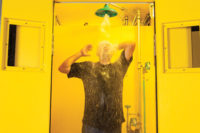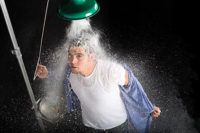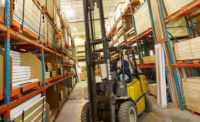Extreme temperatures in deserts and northern latitudes, space limitations in underground mines and the corrosive effects of salt water environments all have to be considered when selecting, siting and designing the quick drench and flush systems that can prevent permanent disability in workers exposed to hazardous materials.
| The Standards |
| Example One |
| Example Three |
| Example Four |
| Example Five |
There is no one-size-fits-all approach for emergency eyewashes and showers. Whether your workplace is in a conventional setting or a more exotic locale, you may find it useful to take a look at solutions that some “challenged” worksites have used to make sure employees have access to this vital and potentially lifesaving safety equipment.
The standards
OSHA’s 1910.151(c) standard provides only the most basic direction when it comes to emergency eyewashes and showers:
“Where the eyes or body of any person may be exposed to injurious corrosive materials, suitable facilities for quick drenching or flushing of the eyes and body shall be provided within the work area for immediate emergency use.”
A much more comprehensive resource is the American National Standards Institute’s ANSI Z358.1 standard, which serves as a guideline for the design, certification, performance, installation, use and maintenance of emergency equipment. This standard specifies the proximity the emergency washing facilities must be to workers (50 feet or 10 seconds – or less, and on a single level), the water temperature range (60-100˚F) and the amount of time that water needs to flow to the affected areas (at least 15 minutes).
It seems relatively straightforward – unless your workplace is like one of the following:
EXAMPLE ONE: A petrochemical plant in Saudi Arabia
The challenge: This desert country’s extremely hot and humid summer temperatures and relatively cool winters cause extreme variations in temperature (from 32˚F to 120˚F) across the seasons, making it difficult to consistently produce water temperature in the ideal range. Excessively hot water can scald an injured worker and potentially exacerbate chemical reactions. Water that is too cold can cause hypothermia and prohibit the full 15-minute drench period. Additionally, a worker who feels chilled may be reluctant to remove contaminated clothing, inadvertently extending the amount of time he or she is exposed to caustic substances.
The solution: Tempering systems on a recirculation loop with a water chiller. This arrangement supplied the tempered water that was needed to reach each of the shower-eye/face washes attached along a 1.5-mile loop. Water pressure, volume and temperature control were paramount design concerns. A custom heating and chilling system was designed based on calculations of the recirculating water’s ideal speed and proper temperature at all points of use. A central control station featuring a programmable logic controller (PLC) is used to monitor temperatures and pressures.
EXAMPLE TWO: A water treatment plant in the Mojave desert
The challenge: The Mojave also has temperature extremes (from 20˚F to 130˚F) as well as a lack of plumbed, full pressure water.
The solution: A stand-alone tempering system with an air conditioner. A custom-designed booth was installed – one that houses both the tempering components and an attached industrial air conditioner chosen for its ability to control the booth temperatures in the chill of the night as well as the heat of summer days. The unit is not only freeze-proof, but manages the water temperature so that the severe summer heat would not cause scalding from the eyewash and shower.
EXAMPLE THREE: Oil sands mining in Canada and natural gas drilling in Alaska
The challenge: Petrochemical operations north of the Arctic Circle must contend with dangerously cold and windy conditions.
The solution: An enclosed shower and tempering unit with special insulation and custom heaters. Even with full enclosures, the northern latitudes require proper attention to heat loss. Specially designed insulated booths, heaters and pre-insulated showers function well even in -30˚F temperatures. With proper engineering, these systems work as smoothly as those in warmer climes.
EXAMPLE FOUR: Underground mines in Canada and Alaska
The challenge: Underground mines require small footprints and carefully chosen solutions. Potable water is required for safety showers so even a standby water tank must be controlled for temperature, pressure, and flow regardless.
The solution: An indoor stand-alone system with custom recirculation pump that includes multiple showers on a loop with a standby tank, controlled by pumps with regular maintenance reviews of the water.
EXAMPLE FIVE: Oil drilling platforms in the Gulf of Mexico and the Grand Banks
The challenge: Although the Gulf of Mexico and the North Atlantic off Newfoundland, Canada are profoundly different in a number of ways, offshore platforms in both areas require stringent attention to materials due to the corrosive nature of the sea water and other chemical exposures. Booths and systems designed for outdoors must also meet wind and seismic conditions.
The solution: Custom corrosion-resistant enclosures with stainless steel plumbing and specialized electrical components such as junction boxes and electrical conduit that can contribute to the longevity of a system on these platforms.
Whatever the conditions of your particular worksite, a safety shower/eyewash specialist can help you determine the appropriate equipment and configurations.




